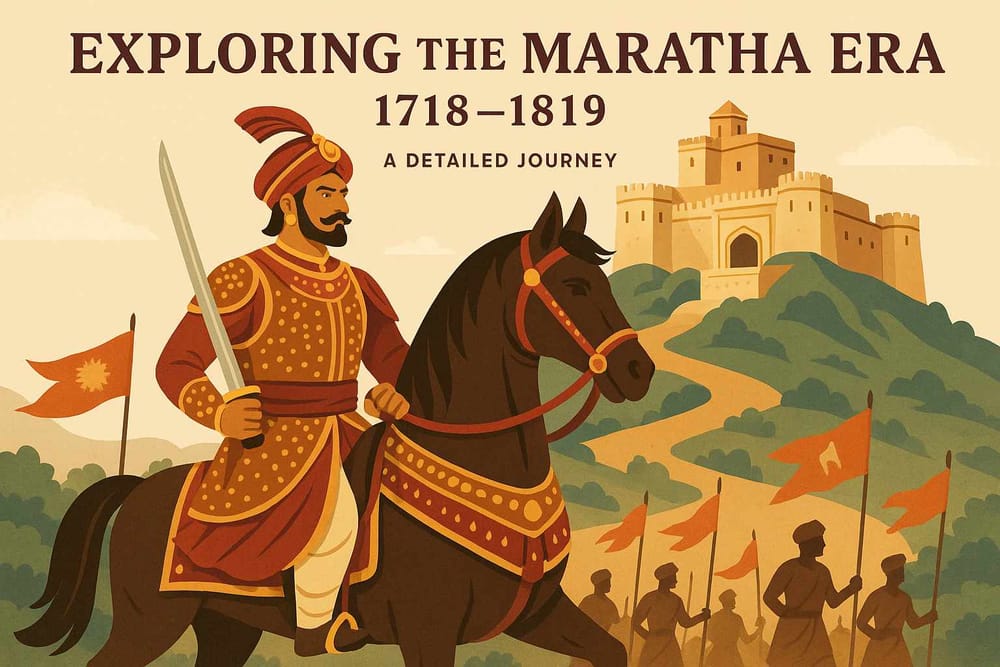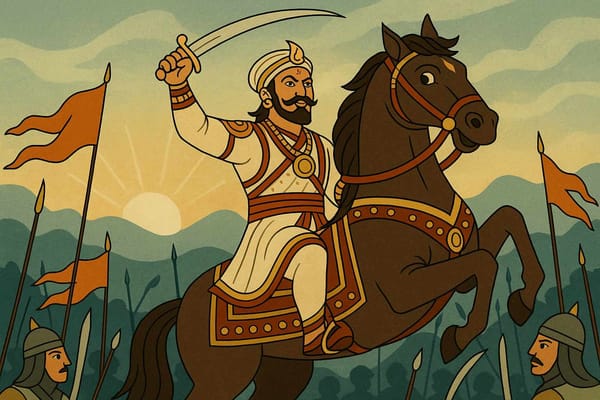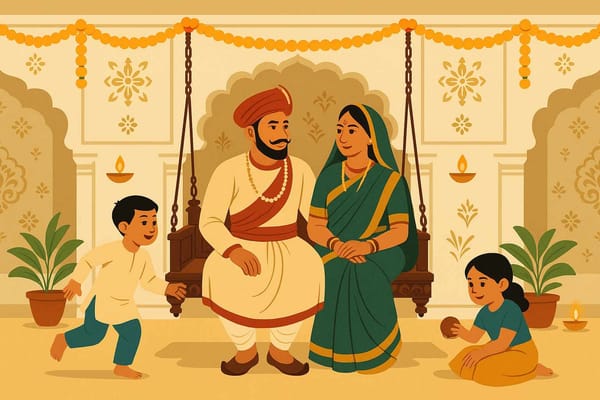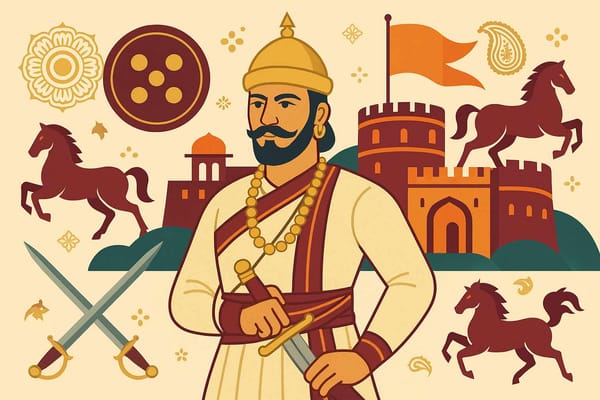
Exploring the Maratha Era 1718-1819: A Detailed Journey
Close your eyes for a moment. Imagine the rugged hills of the Sahyadris, echoing with the powerful cry of "Har Har Mahadev!" Picture a saffron flag, the Bhagwa Dhwaj, fluttering defiantly against the sky. This isn't just a scene from a movie; it was the living, breathing reality of one of India's most formidable powers – the Maratha Empire. For a glorious century, from 1718 to 1819, they didn't just rule; they rewrote the destiny of a subcontinent, leaving behind a legacy of courage, brilliant administration, and a deep, unshakable faith.
This period of Maratha history is more than just dates and battles. It's a story that resonates in the heart of every Indian who values resilience and heritage. It’s a saga of how a regional power rose to challenge the mighty Mughals and, for a time, became the supreme authority in the land. Let's walk through this incredible era together, not as historians, but as inheritors of this grand legacy.
The Architects of an Empire: The Rise of the Peshwas
Every great structure needs a strong foundation, and for the Maratha Confederacy, this foundation was laid by the brilliant Peshwas. Stepping into the role of Prime Ministers, they became the de facto rulers, guiding the empire with a mix of sharp intellect and strategic prowess. It was Balaji Vishwanath who, in 1713, began weaving the scattered Maratha clans into a cohesive force. He established a centralized system that respected regional autonomy, a masterstroke of governance.
His son, the legendary Peshwa Bajirao I, was a force of nature. A warrior undefeated in battle, he dramatically expanded the empire's horizons, carrying the Maratha standard from Gujarat to Malwa and beyond. The leadership of remarkable figures like these, along with Shahu Maharaj and later, Madhavrao I, was the engine that powered the Maratha dream. They didn't just conquer lands; they established intricate revenue systems like Chauth and Sardeshmukhi, ensuring the empire had the resources to sustain its administration and military might.
Masters of Warfare: Strategy on Land and Sea
Have you ever wondered how the Marathas managed to dominate such a vast territory? Their success wasn't just brute force; it was sheer genius in military strategy. They were pioneers of guerrilla warfare, using their swift cavalry to strike and vanish like lightning, leaving larger, slower armies bewildered. This was a warfare born from their deep understanding of the Deccan terrain.
- Forts as the Backbone: The magnificent forts like Raigad and Sinhagad were not merely defensive outposts. They were the very heart of the Maratha spirit—symbols of their sovereignty, administrative hubs, and safe havens for their people. Each stone in these forts tells a story of sacrifice and valor.
- Commanding the Seas: While their land armies were famous, the Marathas, under visionary leaders like Kanhoji Angre, also built a formidable navy. This naval force guarded the Konkan coast, protected crucial trade routes, and challenged European naval powers, asserting Maratha dominance over the western seas.
Their tactical brilliance was on full display in crucial encounters like the Battle of Palkhed (1728) and the Battle of Bhopal (1737), where they outmaneuvered their rivals and solidified their supremacy. They truly reshaped the political map of 18th-century India.
A Flourishing of Culture and Devotion
But the Maratha Empire was not just about swords and politics. It was an era where culture, art, and spirituality blossomed. The rulers were great patrons of architecture, literature, and religion, creating a vibrant cultural landscape that we cherish even today. The magnificent Shaniwar Wada in Pune, though now in ruins, stands as a whisper of their architectural grandeur.
During this time, the Marathi language flourished, becoming the language of administration and literature. More importantly, the flame of the Bhakti movement burned brightly. Spiritual leaders and saints fostered a deep sense of unity and devotion that cut across caste and community, influencing society in profound ways. This focus on faith and culture created a strong social fabric.
This spirit of nurturing arts and heritage was a hallmark of great Indian kingdoms. In a similar vein, one can see how Mewar's rich heritage of traditional arts was also passionately preserved by its rulers, reflecting a shared Indian value of safeguarding our cultural soul. Understanding these connections helps us appreciate the beautiful, interwoven tapestry of our nation's history.
The Final Stand: Resisting the British Tide
As the 18th century drew to a close, a new power was rising in the East – the British. The Marathas were one of the last and most formidable hurdles to their colonial ambitions. The three Anglo-Maratha Wars were a testament to the Marathas' unyielding spirit. Though internal conflicts had weakened the Confederacy, they fought with incredible courage.
The final war (1817-1819) marked the end of the empire, with the British annexing their territories. Yet, the story of their resistance did not end. It became a powerful inspiration for India's future freedom struggles, a reminder that the spirit of Swarajya, once ignited by Shivaji Maharaj, could never truly be extinguished.
Why the Maratha Legacy Matters Today
Why do we look back at this era with such pride? Because it marks a pivotal moment when an indigenous power rose to fill the vacuum left by the declining Mughals. The Maratha empire established a model of decentralized governance and fierce independence that left a lasting impact on India. Their administrative practices, military innovations, and cultural contributions continue to influence us.
Exploring this history is a way to connect with our roots. And in today's digital world, connecting with our past has never been easier. Platforms dedicated to our heritage allow us to explore these stories and traditions from the comfort of our homes.
At Bhaktilipi, we believe in this connection. Our mission is to preserve, reimagine, and share the timeless devotional and cultural stories that form the soul of India. The Maratha era, with its deep roots in spirituality and tradition, is a treasure trove of such stories. We invite you to delve deeper into the spiritual heart of India's great legacies, much like the sacred spiritual legacy of Mewar, which we also lovingly explore.
To continue this journey of discovery and devotion, stay connected with us. Subscribe to our YouTube channel, and follow us on Facebook and Instagram for inspiring stories that bring our rich heritage to life.
A passionate group of people dedicated to preserving India's knowledge of Dharma, Karma, and Bhakti for ourselves and the world 🙏.
Comments
Related in

The Legend of the Lion Fighter: Sambhaji Maharaj's Bravery Inspires
In the heartlands of Maharashtra, stories are not just told; they are lived and breathed. They are passed down from generation to generation, each retelling adding a little more awe, a little more pride. One such story that still gives us goosebumps is that of a king who was as

Chimaji Appa's Personal Life: Family Beyond the Battlefield
In the grand tapestry of Maratha history, the name Chimaji Appa shines brightly, often associated with the thunder of cannons and the brilliant capture of the Vasai fort. We remember the warrior, the strategist, the brother of the great Bajirao I. But behind every formidable warrior is a human being,

Maratha Legacy: Historic Era-Exploration
Sometimes, when you stand on the ramparts of an old fort in Maharashtra, the wind seems to whisper tales of valour. It speaks of a time when a dream of freedom, of Hindavi Swarajya, was kindled in the heart of a young king. This isn't just history; it&
